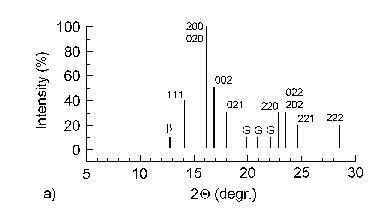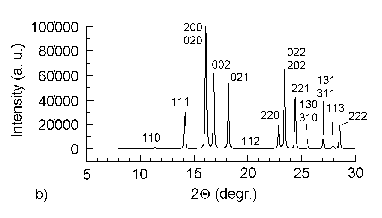
CRYSTAL STRUCTURE OF CuI UNDER HIGH PRESSURE AND SHEAR DEFORMATION CONDITIONS
V.A. Ivdenko1,2, V.D. Blank1,2, N.R. Serebryanaya1,2
1Institute
of Spectroscopy of RAS, Troitsk, Moscow Region, 142092, Russia
2Research
Center for Superhard Materials, 7a Centralnaya St., Troitsk,
Moscow Region, 142092, Russia
Keywords: CuI crystal structure, phase transitions, high pressure, shear deformation.
Earlier [1] two phases have been found in copper(I) iodide at hydrostatic pressures up to 12 GPa. Recently [2, 3] new phase transition has been observed at 18 GPa in CuI. It has been found that the crystal structure of this pressure-indused phase is orthorhombic of ZnTe-III-type (sp. gr. Cmcm) [2].
Use of the controlled shear deformation gives the possibility to influence on kinetics and peculiarities of pressure-induced phase transitions. The X-ray diamond anvil cell (DAC) with the rotating anvil for shear deformation investigations was designed by the authors. The MoKa-radiation and the photoregistration method were used.
Experiments on CuI were carried out in the pressure range 11 - 40 GPa under nonhydrostatic loading without pressure-transmitting medium. The well-known anti-PbO-structure of the pressure-induced phase CuI-V was found to remain under pressures up to 16 GPa. The new pressure-induced phase (CuI-VIII) of the ZnTe-III-type arises with pressure increasing. The unit-cell parameters of this phase are: a = 5.32(4) Å, b = 6.01(4) Å, c = 4.51(2) Å, Z = 4 at 25 GPa, the indexing program DICVOL was used. Space group is Cmcm, the both copper and iodide atoms are in 4c at (0, y, 0.25), yI = 0.188 and yCu = 0.601. The simulation of the diffraction pattern intensities was carried out by DBWS-program.
Anisotropy of CuI-VIII-compressibility has been oserved at 38 - 40 GPa under nonhydrostatic loading and shear defomation conditions. It was revealed that the (200) and (002) reflections are getting closer and the intensity of the (200)-reflection becomes the greatest (figure 1a). Diffraction patterns under such conditions can be indexed in tetragonal (a = 5.07(1) Å, c = 4.85(1) Å, Z = 4) or orthorhombic (a = 5.06(1) Å, b = 5.07(1) Å, c = 4.85(1) Å, Z = 4) structure. The simulation of the diffraction pattern intensities (figure 1b) gives acceptable results for orthorhombic structure (sp. gr. Cmcm) with the atom positions in 4c: I at (0, yI, 0.25), (yI = 0.19), Cu at (0, yCu, 0.25), (yCu = 0.67). Hence, the structure is an orthorhombic because this positions are absent in tetragonal space groups.
This structure is close to that
of CdTe-IV. It is also very close to cubic one (a/c = 1.045, b/c
= 1.046, a/b = 0.999) and has approximately 6-fold coordination
of Cu-atoms. Thus, under nonhydrostatic loading and shear
deformation conditions the orthorhombic distortion of
CuI-VIII-structure is getting smaller.
1. V. Meisalo, M. Kalliomaki: High
Temperatures - High Pressures, 5 (1973), 663-673.
2. M. Hofmann, S. Hull, D.A. Keen: Physical Review B, 51
(1995-I), 12022 - 12025.
3. S.S. Batsanov, N.R. Serebryanaya, V.D. Blank, V.A. Ivdenko:
Crystallography Reports, 40 (1995), 598 - 603.

Figure 1a. Dash-pattern of CuI
under nonhydrostatic pressure of 38 GPa and shear deformation
conditions. - beta-lines, G - gasket.

Figure 1b. Powder simulation of
the fig.1a-pattern.